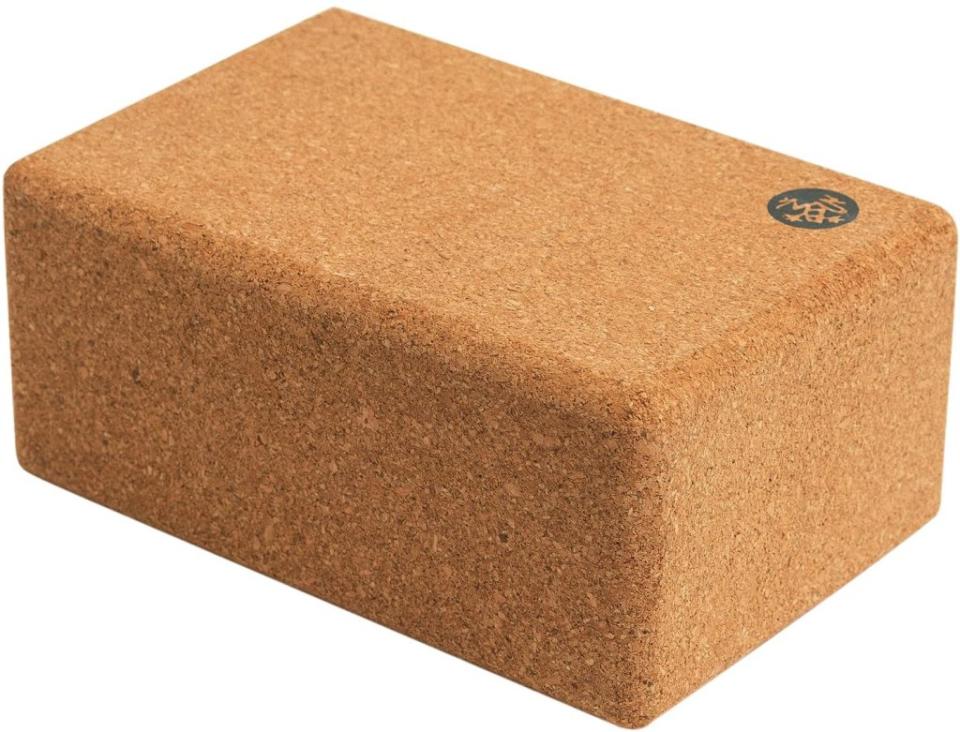The Best Yoga Blocks to Support Any Practice, According to Instructors

Our editors independently select the products we recommend. We may earn a commission on items bought through our links.
For anyone who’s found themselves wobbling in Warrior 3, a yoga block is more than a prop — it’s a lifesaver of a tool that provides support during challenging poses.
Today's Top Deals
Yoga blocks aren’t just for rookies, though, says Nicholas Duran, a certified yoga instructor, NASM-certified personal trainer, and fitness and movement pro at Equinox and Heroic Performance Fitness in Los Angeles. On the contrary, he says, leaning on a yoga block (literally) means you’re serious about your practice and aren’t afraid to ask for a little help along the way, either.
“People sometimes think that if you’re using a prop, it means you’re not able to do a pose properly, but it’s very beneficial to assist with posing,” he says. “Whenever I take a class, I always grab a couple of blocks, whether I feel like I’m going to need them or not.” So whether you’re practicing in a trendy urban studio or a makeshift space in your living room, a yoga block is a handy safety net for precarious poses, even as you advance in your flow.
But besides offering stability in balance, a yoga block can be used to lengthen and assist in poses where you have yet to gain flexibility. For instance, It can help elevate your posture in a seated position or prop the body up during restorative poses so you can fall deeper into relaxation. “You let the block do the work, and it’s awesome,” says Duran.
Yoga blocks come in wood, cork, or foam. Each material offers unique benefits. From the eco-friendly appeal of cork to the lightweight convenience of budget-friendly foam, there’s something for every yogi at a reasonable price point, ranging from $10 to upwards of $40 for a quality block. And while it might seem a bit pricey for a hunk of foam or wood, the extra little investment is well worth the peace of mind when you need to reach for it.
With the help of yoga and fitness experts, SPY researched the best yoga blocks on the market to support any practice.
What the Experts Say
According to Duran, you don’t have to bend over backward to secure a solid yoga block. They’re relatively affordable and easy to find in a variety of materials, price points, shapes, sizes, and sets. “I’ve gotten pretty decent sets, like the Manduka yoga blocks, for 30 bucks and a set for 40 bucks a set,” he says. “I think that’s pretty reasonable because I use them so often and I wanted them to be sturdy.”
When shopping, you should consider the following features to determine what type (and how much to invest) in your yoga block(s):
Material: From wood, cork, and foam to pillowy bolster cushions, your yoga block’s materials offer more than just aesthetics. Each material choice offers different benefits tailored to specific yoga sessions and yogi needs, whether it’s slip resistance, stability, comfort, or portability, says Duran.
Foam blocks (made with high-density EVA foam) are lightweight and provide firm cushioning, which makes them ideal for restorative (tension-release) yoga.
Cork blocks are denser, yet still relatively light and comfortably soft, making them a strong tool for restorative or strength-building sessions where stability is key.
Wood is a heavier solid option for supporting a lot of body weight or force (e.g. standing on), and offers non-slip balance during hot yoga classes, but is less ideal for sensitive areas of the body (e.g. the back, neck, or tailbone).
Bolster or pillow cushions, while technically not “blocks,” are perfect for yin (stretching) or restorative yoga and provide extra comfort and support during long-held poses.
Duran recommends opting for a block that will provide well-rounded support and comfort for what style of yoga you practice most.
Size: When considering the size of a yoga block, it’s also helpful to think about how it will accommodate your height and body frame. “Size can be a big factor for a person’s body size, depending on how you’re using it,” says Duran. Most blocks are a standard 4-inch, but there are smaller 3-inch and larger 5-inch options available. While a standard 4-inch will work for most on the mat, a smaller or larger size can help you lock in better alignment and support if you need it, according to Duran.
Also, a wider block can provide more surface area for support and stability, making it ideal for taller individuals or those with broader frames. A narrower block might feel more comfortable for petite practitioners or those with smaller hands, allowing for a better grip and control during poses.
Shape: During yoga poses, the specific shape of a yoga block can help you feel more stable, comfortable, and supported. While standard rectangular blocks are versatile and most commonly used, unique shapes like curved or wedge blocks offer additional benefits for specific poses.
Curved blocks or bolster cushions fit the body’s natural curves, so they sometimes provide better support, comfort, targeted stretch, and alignment in certain restorative or yin poses where the body needs to curve or arch, such as backbends, heart openers, bridge pose, or even supported Child’s Pose.
Wedge blocks can elevate and support when you need more height during seated forward folds or reclining poses; they can also lessen pressure on the knees, wrists, or calves during downward dog or forward folds, or even allow you for a deeper stretch into certain poses (e.g. Warrior 1 or Pyramid Pose).
If you’re just starting out, Duran says standard-shaped blocks work just fine for most people, unless they have sensitive areas of the body. “I just always stick to the rectangular ones [because] I find that they’re so functional,” he says.
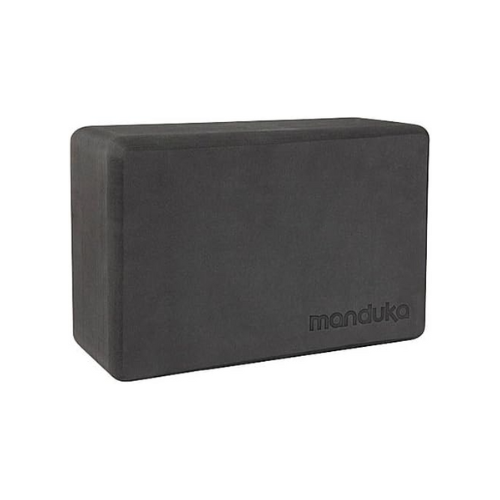
BEST OVERALL
Manduka Recycled High-Density Foam Yoga Block
Buy Now On Amazon
Buy Now At REI
Buy Now at Manduka
Topping our list of yoga blocks that rock, this popular Manduka block is exceptionally supportive, eco-friendly, and versatile. The standard 4-inch rectangular block is a versatile stabilizing, alignment, and support tool for any skill level, according to Duran. Made from recycled, high-density EVA foam, it’s super lightweight but durably ding-resistant (for foam), so you can tote it to and from the studio with ease.
Duran’s personal yoga block of choice, he appreciates the high quality. “It’s a really nice firm foam block that’s durable but light,” he says. “It’s less expensive than the cork block [version] but similar-feeling – it feels like it has substance. You could stand on this block with your body weight, and it’s going to hold.”
Manduka’s Yoga Block is comfortable and easy to hold thanks to its slip-resistant surface and beveled edges. Its firm support and wrist-friendly cushion for sensitive wrists and other tender areas, like the hips, back, or shoulders.
Retailing for $22, this quality yoga block is a proven worthy investment for new and seasoned yogis, alike, looking for a long-lasting, versatile block that’s sustainably made.
Also Consider: What we’d consider our runner-up (if we had to choose) is Alo Yog’s Uplifting Yoga Block, which offers similarly firm support, and beveled edges for comfort, but is a touch more expensive.
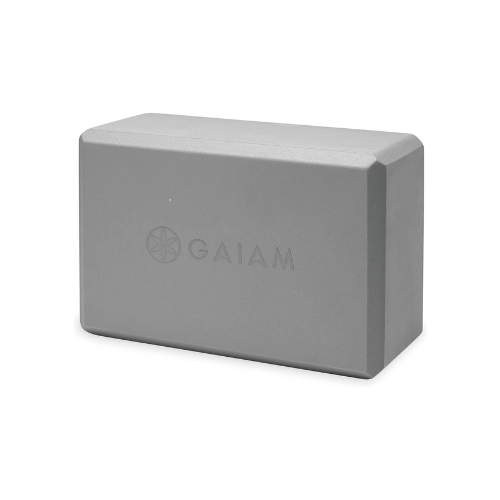
BEST BUDGET
Gaiam Essentials Yoga Block
Buy Now On Amazon
Buy Now At Get Actv
For frugal yogis on a budget or beginners just getting into their practice, Gaiam’s Essentials Yoga Block is a steal. The standard size block covers all the vital bases of a pricier pick with its firm, but comfortable, versatile support.
Constructed with lightweight EVA foam, this block holds up against commutes and sweaty sessions. Like the Manduka, its beveled edges and surface are easy to grasp as you balance or modify positions, and it’s comfortable when used to bolster the body. This economically sound option is also easy to clean post-session with the swipe of a mild cleanser.
Sure it’s not as trendy or made with high-tech materials as some twice its price, but this affordable block comes at a thrifty price tag of $12. Plus, get it with a bonus strap for $16, as a 2-pack for $19, or set for $20.
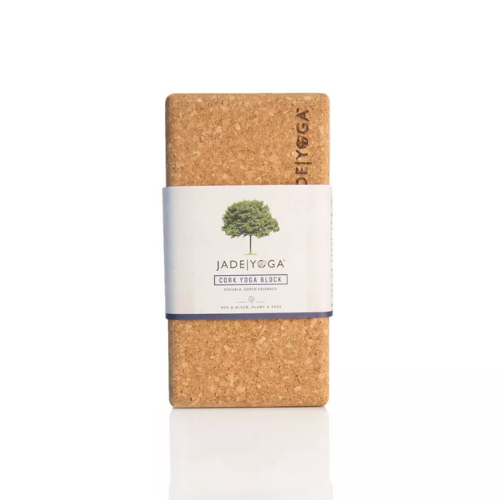
BEST CORK
Jade Cork Yoga Block
Buy Now At REI
Buy Now At Target
Buy Now At Jade Yoga
Another top pick by Duran, the Jade Cork Yoga Block is impressively strong with sturdy sides and soft, beveled edges that make alignment and balancing a breeze. Firmer than foam and longer-lasting, too, it is sustainably made and naturally antimicrobial. Its textured surface has great grip and traction on the mat, which makes it ideal during all kinds of dry and hot sessions, especially the sweaty, slippery ones.
“Compared with wood blocks, you can use [cork blocks] for restorative poses,” adds Duran, but notes that cork doesn’t have the same soft ‘give’ as its foam counterparts, so new yogis might find it less comfortable on their joints or other sensitive areas. Regardless, more experienced individuals love the security that this reliable block lends to improve their flexibility without fear of pain or injury. Best of all, it comes in two sizes, a standard 4 by 6 by 9 inches and a smaller 3 by 4.75 by 9 inches for petite persons or smaller areas of use.
The Jade Yoga Cork Block retails for a competitive $22, which we think is a great price point considering its high quality, superb grip and performance, and earth-friendly sustainability
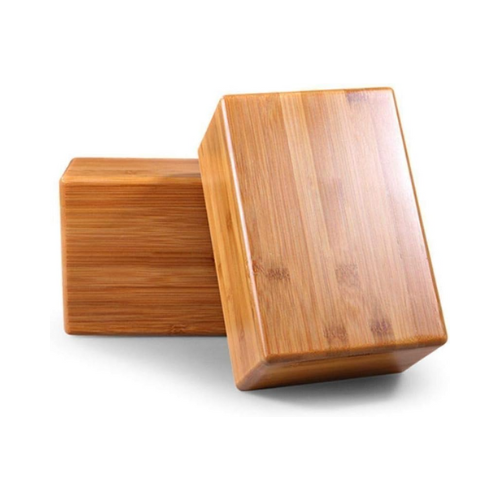
BEST WOODEN
Wooden-Life Bamboo Yoga Blocks
Buy Now On Amazon
Crafted from high-quality bamboo, The Wooden-Life Bamboo Yoga Blocks are the sturdiest options on our list. Whether used to deepen stretches, provide additional support, or assist in challenging poses, these blocks won’t flex, warp, or wear as foam or cork options might. An eco-friendly alternative to most foam blocks, they won’t absorb sweat, grime, or bacteria, making them hygienic, easy to clean, and quick to dry.
They’re also inherently strong. The bamboo used for these blocks can hold a ton of body weight and force, so this set is perfect for standing poses, stacking, and larger individuals. Each 3-inch block has a lacquered finish with smooth, rounded edges that are easy to hold, allowing for safe, seamless transitions between poses. While the set does get somewhat slippery during wetter sessions, they’re otherwise grippy — just a bit more ideal for dryer practices.
With their eco-conscious construction, durability, and ergonomic design, the $30 set is a great value that’s sure to support any practice for years to come.
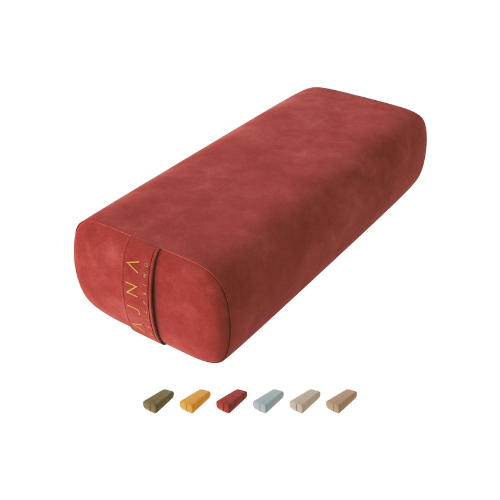
BEST BOLSTER
AJNA Yoga Bolster Pillow
Buy Now On Amazon
Okay, so this isn’t really a yoga block, per se, but this bolster is well worth the consideration for any serious practice. Great for restorative or yin flows, this bolster provides a larger area of support than standard blocks. It’s designed to relieve unnecessary strain and tension during backbends, heart-opening, or bridge poses, as well as allow for deeper relaxation when in Child Pose, Savasana, and more.
Unlike many bolsters stuffed with buckwheat or cotton, this non-toxic pillow is filled with dense recycled foam that never loses its shape and supports your body any way you use it. It’s covered with a removable (and machine-washable) vegan suede cover that’s available in several nice, earthy colors. The convenient handle makes it easy to move and use this comfy bolster around your space so you can use it for lumbar or body support in other settings, like watching a movie, working in bed, or giving a loved one a massage.
AJNA’s Yoga Bolster is a bit of a splurge at $70, but this is one investment your spine will thank you for.
Also consider: If you’d like to save a few bucks, Gaiam’s Yoga Bolster Meditation Pillow offers softer support with a slightly wider, rounder base and a machine-washable cover at an even more affordable price.
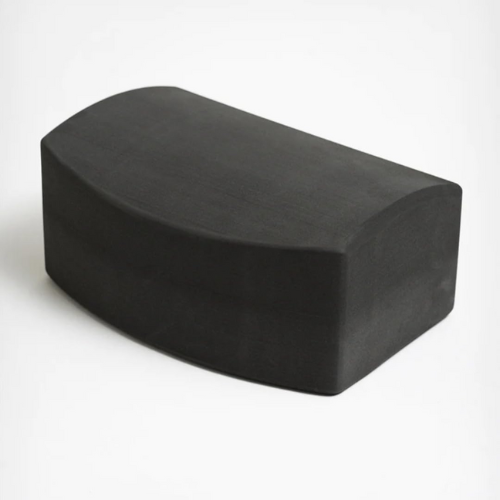
BEST CURVED
Manduka UnBlok Yoga Block
Buy Now On Amazon
Buy Now At Manduka
If you use blocks under your back or have sensitive wrists during practice, Manduka’s UnBlok Yoga Block is a must-have. Made with the same high-density EVA foam as the Manduka block topping SPY’s list, this 4-inch block has one arch-shaped side for a cleverly elevated, supportive experience.
When used under the back, the Manduka UnBlok Yoga Block is great for stretching and relieving back and shoulder pain, as well as correcting the dreaded laptop hunchback of office workers everywhere. The curved shape also puts less strain on the wrists than fully rectangular blocks.
Price-wise, this sustainably-made block is worth every penny of its $26 price tag.
Also consider: Lululemon’s Inner Flow Yoga Block has a chic, marble design and two curved edges for comfortable stability, grip, and use on the upper body areas, like the neck, and spine. Or, for a more budget-friendly option, Giam’s Crescent Yoga Balance Block is long enough to double as two blocks for some poses but doesn’t give as much height due to its limited ways to rotate and stand it on end. Still, it’s versatile and comfortable for a variety of uses, and half the cost.
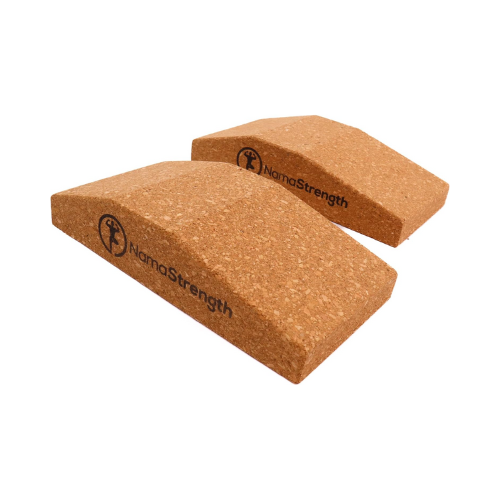
BEST WEDGES
NamaStrength Cork Yoga Wedges
Buy Now On Amazon
Buy At Nama Strength
Designed with wrist support in mind, NamaStrength Yoga Wedges feature a unique ergonomic incline to alleviate excessive pressure and extension of the wrist joints during yoga. Beyond being gentler on your wrists, you can use these wedges to either relieve pressure on knees, calves, or ankles or even deepen a stretch. Their usefulness doesn’t stop there, weightlifters can take this set beyond studio walls for use as squat wedges for lifting to achieve a deeper, safer lift.
Made from high-density, antimicrobial cork, they are more eco-friendly and moisture-proof than many foam wedges. Their non-slip cork surface provides excellent grip, even in hot yoga conditions where things might typically get slippery when wet.
These unique and useful wrist-savers, which retail for $40, are a handy pair (pun intended) for yogis wanting to deepen their yoga practice while being kind to their joints and the planet.
Frequently Asked Questions About Yoga Blocks
How Do You Use a Yoga Block?
According to Duran, you can lean on your yoga block (literally) anytime you need extra support and alignment, stability for balance, or as an extension to lengthening your body in your pose.
“If you’re trying to reach towards the ground, and maybe your hands don’t quite reach, it gives you a little bit more height so that way you’re able to get into the pose a little bit better,” he says. “To bring the floor ‘up’ a little bit closer to you is always more beneficial than overextending the spine or rounding shoulders,” he says. When positioned under the hand or foot during balancing poses, blocks help you to stabilize yourself for a safer experience that also promotes proper form in the long run of your practice.
You can also use blocks to prop up the body for support during restorative (mind and body tension release) and yin (stretching) poses for gentle support and relaxation when positioned under the knees or along the spine. “I love heart openers on the blocks and hip openers on the blocks. I think they’re just super helpful, super useful,” says Duran. Another helpful use is placing a block or bolster under the sacrum or between the shoulder blades during backbends or bridge poses to support the back.
Blocks help yogis enhance alignment and accessibility in various poses, too. Sitting on a block elevates the hips, which can make seated poses more manageable, particularly if you have tight hips or knees, says Duran. Blocks further assist in hip-opening poses by reducing strain on the hips and knees while maintaining alignment.
For advanced yogis, blocks can provide a means of modification in inverted postures, like shoulder stands and headstands, offering support under the head or between the shoulder blades to enhance stability and alignment. They can even be used together in multiples, stacked, or in conjunction with bolsters. While there are dozens of creative ways to use yoga blocks, you should always start slowly and carefully for safety, preferably under the guidance of a qualified yoga instructor, who can offer personalized guidance based on individual needs and abilities.
How Much Should I Spend On Yoga Blocks? Do I Really Need More Than One?
The price of your yoga block usually depends on its material, brand, and type (standard, wedge, curved, or bolster), and generally ranges in cost from $10 to upwards of $50 for one block, $30 to $90 for a bolster, and $15 to upwards of $60 for a set. The more specialized the block (i.e. bolster, wedge, special contouring) or the more items in a set, the more you’ll pay at checkout. There’s no right or wrong answer, says Duran, so decide what type of support experience you want and invest from there.
For example, he likes having two blocks. “I prefer to have [at least] blocks in sets because you can always just use one block, but I think it’s more useful to have two blocks of the same size,” says Duran. “I like to set them up on either side [of the mat] where they’re easy to grab and use throughout your practice.”
If you’re new to yoga or only practice light, restorative yoga once or twice a week, you’re just fine using an affordable standard foam or cork block. If you get into an intense practice that has you sweating or leaning deep into challenging poses, you’ll want something durable, non-slip, and extra sturdy, like dense cork, wood, or a high-grip curved block. The more types of yoga you practice (e.g. power, strength-building, restorative, yin), you might consider a small collection of blocks, wedges, and bolsters, but only if it’s helpful for range of motion, comfort, and support.
Are There Any Yoga Blocks I Definitely Shouldn’t Buy?
Generally speaking, it’s best to steer clear from yoga blocks made from low-quality materials that lack durability, since they might not be supportive and stable enough. Duran says some foam blocks can be too soft to properly support your body weight, which can compromise your form and safety, not to mention lead to a deformed, short-lived purchase. Likewise, yoga blocks with sharp edges, uneven surfaces, or fumy odors can be uncomfortable, unsafe, and distracting to your flow.
Duran also recommends avoiding small, large, or niche yoga blocks that might not serve your body size or the versatility you need. For example, “If your block’s too narrow, it’s not going to feel as comfortable on the shoulder blades or won’t feel as supportive,” he says, noting the importance of practicality. “I prefer the average width block because I think there’s just more function to it.”
Ultimately, it’s most important to invest in yoga blocks that are made from high-quality, non-toxic materials, with solid construction and smooth, beveled, or rounded edges in a useful style that will give you the best overall experience with your investment.
How Do I Clean This Thing?
Most foam and cork blocks are made with antimicrobial and moisture-resistant materials, but it’s important to give yours a regular cleaning to maintain its longevity and prevent a buildup of sweat and grime, or the spreading of germs. After a session, Duran recommends a quick wipe-down of your block using a damp cloth and a mixture of mild soap and water or whatever gentle cleansing spray you use for your mat. Always follow the manufacturer’s recommendations and avoid harsh chemicals or abrasives that could damage the block’s surface, especially if it’s natural cork or wood.
For a deep clean, you can mix water with a small amount of vinegar or use a gentle all-purpose cleaner. After cleaning, rinse the block thoroughly with clean water and allow it to air dry completely before storing or using it again.
Is it Weird to Share a Yoga Block?
It’s common for studios to lend out communal blocks, but we’ve all been there. Whether it’s a product of the post-pandemic era or you’re just a mild germaphobe, it’s totally reasonable to quietly cringe at whose hands were on the set of loaner blocks. Thankfully, instructors like Duran take extra care to upkeep their equipment for the safety and quality of your experience. That being said, for the sake of the next yogi, it’s always best to practice good studio etiquette and wipe down all borrowed equipment after class, especially after a hot and sweaty session.
Proceed to Checkout
More Top Deals from SPY
Best of SPY
SPY connects you with the latest top-rated products in tech, style, grooming, fitness and home essentials. Our expert team of editors and product reviewers have researched and vetted over 100,000+ products to bring you only those worth your money. Our job is to do the research for you so you can spend time enjoying your purchase rather than shopping for it. Most importantly: We never recommend a product or service we wouldn’t buy ourselves.
1. Gaiam Yoga Block
The Gaiam Yoga Block is our top pick thanks to its supportive, lightweight design and nonslip grip, which makes it perfect for hot yoga sessions. Beveled edges make this block comfortable to grip in any position. The latex-free block can easily be cleaned with a mild detergent and the affordable and durable block is available in a huge variety of colors that are sure to please any yogi.
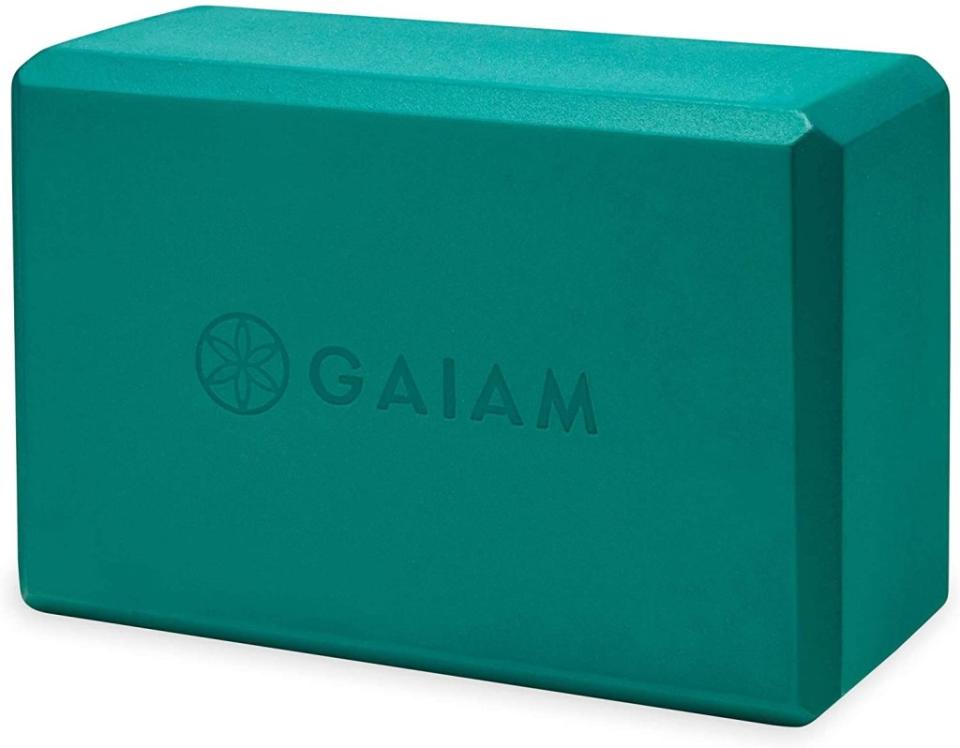
Gaiam Yoga Block
2. REEHUT Yoga Blocks
The Rreehut Yoga Block is sold in a pair and makes an excellent yoga block for anyone looking for something that is sturdy, durable, and moisture-proof ie. great for fighting sweaty bacteria. The lightweight blocks are great for carrying from your home practice to the yoga studio, which helps keep your sweat to yourself. Available in six colors, the Reehut Yoga Block is so affordable you’ll be able to pick up a pair in each hue.
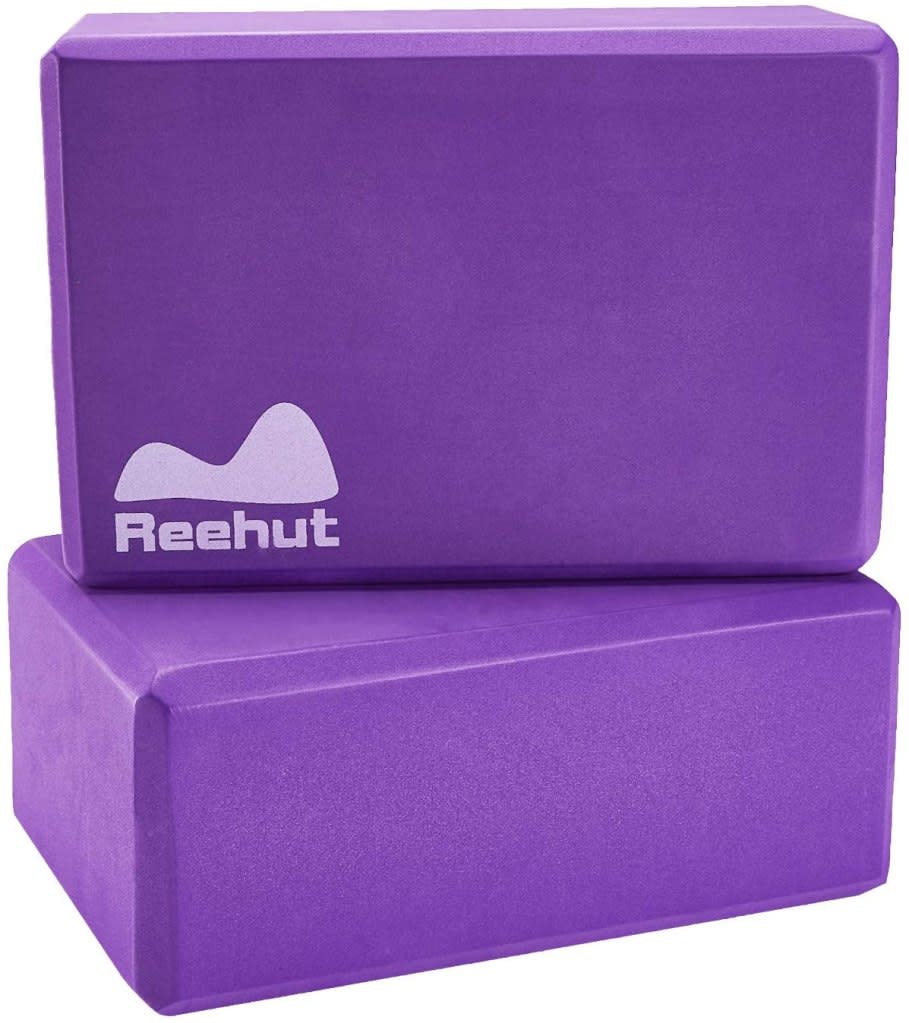
REEHUT Yoga Blocks
3. Manduka Cork Yoga Block
Foam is the most common material used for yoga blocks, but not far behind is cork. There are several styles available and we like Manduka’s cork block, which has an easy-to-grip textured surface that makes it ideal for hot yoga enthusiasts. The two-pound cork block is made without any toxic chemicals, helping users feel safe when getting sweaty.
